







|
|
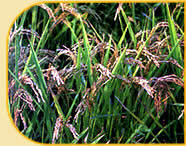 During
the spring, the tongue of flat land stretching from the Biellese towards
Vercelli becomes a sort of sea divided into squares and, in the summer, a
sweep of yellow waving in the wind. The cultivation of rice has
deeply modified the landscape and had a great impact on the gastronomic
culture of the entire area. Maize or Indian corn (the planting of
which first spread during the eighteenth century) is another cereal which,
in the form of polenta (a corn-meal mush), represents a major element
in the diet of both mountain and valley dwellers to the extent that its
happy marriage with dairy products is its most characteristic feature. In
the past, the people descended from the hills and mountains to the plain in
order to exchange chestnuts and cheeses for rice and maize
and, as a consequence, the products of the plain have become essential
ingredients of typical mountain dishes, such as "pulenta cunscia". During
the spring, the tongue of flat land stretching from the Biellese towards
Vercelli becomes a sort of sea divided into squares and, in the summer, a
sweep of yellow waving in the wind. The cultivation of rice has
deeply modified the landscape and had a great impact on the gastronomic
culture of the entire area. Maize or Indian corn (the planting of
which first spread during the eighteenth century) is another cereal which,
in the form of polenta (a corn-meal mush), represents a major element
in the diet of both mountain and valley dwellers to the extent that its
happy marriage with dairy products is its most characteristic feature. In
the past, the people descended from the hills and mountains to the plain in
order to exchange chestnuts and cheeses for rice and maize
and, as a consequence, the products of the plain have become essential
ingredients of typical mountain dishes, such as "pulenta cunscia".
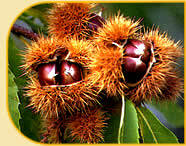 Furthermore,
ambulant merchants from the Ligurian coast crossed the plain in order to
penetrate the mountains with their preserved fish, now widely used in the
local cuisine: anchovies were and still are an essential ingredient for the
"bagna cauda", the typical Piedmontese hot savory eaten with
polenta, whose Biellese version is characterized by the use of walnut oil
(now once again produced for demonstration in the Museum Workshop of
Mortigliengo) and salted cod, cooked with onions, milk or tomatoes. For the
people living in the hills, chestnuts represent a century-old and
fundamental resource that became an essential part of the local culinary
tradition and economy: boiled chestnuts were eaten with milk or wine,
combined with rice, ground into flour, and cooked as a kind of soft and
nutritional polentina; dried and cleaned, they were bartered for other types
of food and, although they were not an expression of well-being, they were a
source of economic independence. They are still used today in the
preparation of risottos, soups and sweets. Furthermore,
ambulant merchants from the Ligurian coast crossed the plain in order to
penetrate the mountains with their preserved fish, now widely used in the
local cuisine: anchovies were and still are an essential ingredient for the
"bagna cauda", the typical Piedmontese hot savory eaten with
polenta, whose Biellese version is characterized by the use of walnut oil
(now once again produced for demonstration in the Museum Workshop of
Mortigliengo) and salted cod, cooked with onions, milk or tomatoes. For the
people living in the hills, chestnuts represent a century-old and
fundamental resource that became an essential part of the local culinary
tradition and economy: boiled chestnuts were eaten with milk or wine,
combined with rice, ground into flour, and cooked as a kind of soft and
nutritional polentina; dried and cleaned, they were bartered for other types
of food and, although they were not an expression of well-being, they were a
source of economic independence. They are still used today in the
preparation of risottos, soups and sweets.
The low yielding agriculture and widespread pastures of
the Biellese have had a profound effect on its traditional cuisine, which,
although based on just a few ingredients, has used them in such different
ways in various parts of the province creating highly differentiated local
dishes.
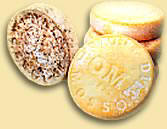 Cheeses Cheeses
Every valley produces its own particular cheeses, the queen of which is
toma: in the western area of the Cervo and Oropa valleys, the
prevalent type is a semi-fat cheese, whereas that in the eastern Mosso and
Valsessera valleys is made of full cream milk and is called Maccagno.
The fresh cheeses (or "tumìn") become "sancarlìn"
with the addition of pieces of garlic and hot peppers; flavored with oil,
vinegar and spices, they take the name of "frachèt", and if
they are left to steep whole in oil with an abundance of paprika, they
become the hot "tum“n eletric". Fresh and aged cheeses are both
ingredients of special fondues, such as the unique "fundua 'd
zeile", in which fresh toma is made to melt in egg and garden sorrel.
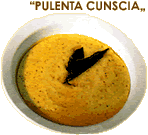 First
courses First
courses
Together with dairy products, the real protagonists of this originally
genuinely rustic cuisine are its soups, broths and polenta,
a type of corn-meal mush. One of the traditional dishes of the Oropa valley
(but whose fame has now spread beyond the borders of Biellese) is "pulenta
cunscia", a soft and creamy corn mush cooked for a long time in a
special copper pot called "paiolo", in which a large quantity of local
cheese is melted and mixed with tasty dairy butter; the same condiments are
used to flavour "ris an cagnùn", a dish of boiled rice mixed
with toma and lightly fried butter. Both of these simple and ancient
preparations bring together the resources of the Alps and the plain. Rice is
also a fundamental ingredient of "mactabe", a thick soup that
made up the evening meal for many generations of the people in the Biellese,
"ris e riundele" (rice and malva), and "minestra marià"
(rice with beets or wild spinach), to name just some of the primi piatti
(first coursesb) which, depending on the season and the valley, contribute
towards the gastronomic repertoire of the province. The bread-based soups
also have a wide variety of flavors, and include the excellent "supa
mitunà" which, in the spring, is enriched with the unpredictable
taste of wild herbs - sometimes sweet, sometimes bitter, sometimes very
marked - and, in the winter, is completely transformed by the use of leeks
and savoy cabbage.
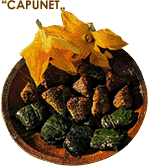 Main
dishes Main
dishes
Meat, which was once only rarely and triumphantly presented (stuffed hen,
rabbit in "scivé" and stuffed "sacoccia" were
reserved for special occasions) now enters as a timid ingredient, together
with eggs, vegetables and garden herbs, in roulades of "capunét"
- wrapped in beet or cabbage leaves - squash flowers and onions. There are
many different types of salami (one of the most common being "salam 'd
l'ula": i.e. preserved in fat), which are also used in the
preparation of such traditional dishes as "frità rugnusa" (an
omelet with salami) or "verzata" (a rich soup of savoy cabbage
and salami that is almost a meal in itself). The trout of the
mountain streams and the whitefish of the Lake Viverone are justly
renowned for their delicacy.
 The
specialties The
specialties
Although every village has its own particular sweet, one that is typical of
the Biellese as a whole is "l'arsumà", a soft mousse of egg and sugar
diluted with milk or wine, which should be eaten with torcetti and
biscuits fresh from the oven, or with the thin cornflour wafers called "miasce".
The mineral waters of the Biellese are famous for their exceptional
lightness (the water Lauretana, low in mineral content, today is the heir of
an ancient hydrotherapeutic tradition), but there is also no lack of wine,
including some well-known D.O.C. (guaranteed origin); Biella is also the
home of Menabrea, one of the best lagers in the world. Finally, particular
mention should be made of Ratafià di Andorno, a drink made of wild cherries
steeped in alcohol according to a 500-year-old recipe.
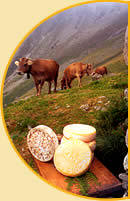 Cheeses Cheeses
The Biellese is rich in cheeses, one of the best known of which is
toma, a hard cheese made of cows' milk that has along Alpine
tradition. It is produced using full-cream (Maccagno) or partially
skimmed milk. The cheeses of the Biellese valleys are also protected by
a D.O.C. mark (controlled origin) of the Piedmont Region. Beddu,
a cheese made of skimmed milk that is as wide as toma but only two
fingers high, is typical of the area around Pralungo: it is eaten fresh
or after aging on a straw bed. Regional fresh cheeses are characterized
by their quality and variety (Sordevolo, ricotta, tumin),
characteristics also present in the goat cheeses, be they fresh, aged or
variously seasoned.
The most widespread are "salam 'd l'ula",
preserved in fat, which are prepared using pork, salt, pepper and,
sometimes, red wine. Equally characteristic are "salam 'd vaca"
(beef), "salam d'asu" (donkey), and those made from goat's
meat. More localized examples are "salam 'd patata" (which
includes boiled potatoes and little bit of blood) and "paletta di
Coggiola", a shoulder of ham flavored with salt and pepper
packed into bladder skins and left to dry in the air. Cheeses and
salamis can be found in specialist shops, and during weekly markets and
seasonal village festivals.
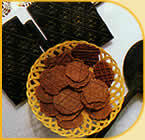 Sweets Sweets
Torcetti, "paste 'd melia" (made of corn
flour) and "turcetùn" (large torcetti made using a less
rich pastry) are still produced according to traditional recipes by some
confectioners (particularly in Andorno, Pollone and Biella). The
confectioners of Biella and Cossato make canestrelli
(fragrant wafers made of chocolate and hazelnuts). At Crevacuore, it is
possible to find home-made "canestrej", which are
chocolate wafers cooked between the plates of a red-hot grill and
prepared according to a recipe that dates back to the XVII century.
 Honey
and fruit mustards Honey
and fruit mustards
The large variety of blossoms in the area make it possible to choose from
among a wide range of honeys, the most common of which are
acacia, chestnut, linden, rhododendron, dandelion and mountain flower.
In the Biellese, in addition to being used as a sweetener, there is an
old tradition of serving honey with polenta. During village festivals it
is still possible to find apple and grape mustards, which are prepared
by condending the fruit juices by simmering the fruit (sometimes for
more than 12 hours) creating a thick, dark syrup to accompany boiled
meats, fresh cheese, polenta and paletta.
Lessona
A rare and precious wine, this is produced in the hilly area from which
it takes its name, a few kilometres from Biella. A garnet red colour with
hints of orange as it ages; intense bouquet, fine and delicate, reminescent
of violet; dry, pleasantly tannic flavour, agreeable, with great character
and a persistent after taste. An ideal companion for: game and red
meat in general.
Grape: Nebbiolo (Spanna), Vespolina and Bonarda may also be present
up to 25%. Minimum alcohol content: 12%.
Aging: obligatory 2 years, one of which in wooden barrels.
Bramaterra
Born from the fortunate combination of the Nebbiolo vine and the
particular nature of the terrain of this region, which provides its natural
habitat, it is a formidable wine, full of flavour, velvety, with a
characteristic garnet red colour and a pleasantly bitterish undertone. Its
production area lies between Masserano, Brusnengo, Curino, Villa del Bosco
and Sostegno.
An ideal companion for: game and red meats in general.
Grape: Nebbiolo (Spanna) 50/70%, Croatina 20/30%, Bonarda and
Vespolina, alone or together, up to 20%.
Minimum alcohol content: 12%.
Aging: obligatory 2 years, of which at least 18 months in wooden
barrels.
Costa della Sesia
Very recently approved according to D.O.C. regulations, the wines of
this appellation are divided into: "Red", "Rosé", "White", "Nebbiolo", or "Spanna",
"Bonarda" or "Uva rara", "Croatina" and "Vespolina". Production area:
Lessona, Masserano, Brusnengo, Curino, Villa del Bosco, Sostegno, Cossato,
Mottalciata, Candelo, Quaregna, Cerreto Castello, Valdengo and Vigliano
Biellese.
Canavese
Most recent addition to Piedmont's D.O.C. wines. The appellation "Canavese"
is divided into "Red", "Rosé", "White", "Nebbiolo" and "Barbera".
Production area: Cavagliá, Dorzano, Roppolo, Salussola, Viverone,
Zimone.
Erbaluce
One of the Region's few white wines. Production area: the
province of Turin, with Caluso as its epicentre, extending up to the
Canavese and Biella districts. In the province of Biella it can be found in
Viverone, Roppolo and Zimone, where the terrain is of glacial origin and
ideally exposed. Erbaluce come in different types:
Erbaluce di Caluso: Intense straw-yellow with
hints of gold; subtle, delicate bouquet, reminiscent of flowers of
the field; dry, agreeably acidic persistent taste. An ideal
companion for: appetizer and fish. Grape: Erbaluce 100%.
Minimum alcohol content: 11%. Aging: not contemplated.
Caluso Passito: A brilliant yellowy-gold color with
a hint of shadow; characteristic ethereal, delicate bouquet; its flavor is
sweet, harmonious, full-bodied and velvety, the result of a long process
which demands that the grapes are hand-borne to the press to avoid damage by
lying them on straw lined gratings. Before pressing, the grapes are left to
"appassire" (a kind of drying process) for a few months (hence the name "passito").
Grape: Erbaluce, sometimes with local Bonarda (5%). The grapes must be
naturally dried to give a sugar content no lower than 30%. Minimum
alcohol content: 13,5%. Aging: obligatory for 5 years, blending
with wines from other vintages is allowed in this time.
Erbaluce Spumante Brut (sparkling): Most recent
addition to the Erbaluce family, this wine is slightly sparkling with a pale
straw colour; light evanescent froth and fine, persistent perlage;
characteristic delicate bouquet and dry, fresh, fruity flavor. Grape:
Erbaluce 100%. Minimum alcohol content: 11.5%.
Aging: none.
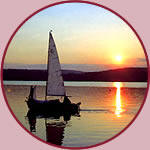 This
itinerary (more information about it at the tourist office) takes you
through the lands and wines of the Biella district. It departs from Lake
Viverone, a popular resort surrounded by the slopes producing the Doc
(controlled origin designation) wines of Canavese and Erbaluce. The lake's
natural environment is perfect for pleasant rambles on foot, bicycle or
horseback, in addition to water sports. Nearby is the Castle of Roppolo,
headquarters of the Enoteca Regionale della Serra (Serra regional wine
center – see below) where all the region's wines can be tasted and
purchased. From there Biella is within easy reach by road, where you can
visit the the town's medieval centre, Piazzo, try Canestrelli, the town's
delicious traditional sweet, or Ratafià, a characteristic liqueur produced
in nearby Andorno. before proceeding to Europe's third largest Sanctuar,
Oropa, a monumental place of pilgrimage. This
itinerary (more information about it at the tourist office) takes you
through the lands and wines of the Biella district. It departs from Lake
Viverone, a popular resort surrounded by the slopes producing the Doc
(controlled origin designation) wines of Canavese and Erbaluce. The lake's
natural environment is perfect for pleasant rambles on foot, bicycle or
horseback, in addition to water sports. Nearby is the Castle of Roppolo,
headquarters of the Enoteca Regionale della Serra (Serra regional wine
center – see below) where all the region's wines can be tasted and
purchased. From there Biella is within easy reach by road, where you can
visit the the town's medieval centre, Piazzo, try Canestrelli, the town's
delicious traditional sweet, or Ratafià, a characteristic liqueur produced
in nearby Andorno. before proceeding to Europe's third largest Sanctuar,
Oropa, a monumental place of pilgrimage.
 Oropa
is also an obligatory culinary pause to enjoy the renowned hot chocolate, or
a plate of polenta concia (maize porridge with fondue cheese) in one of the
numerous nearby restaurants. Returning to Biella, we visit Candelo next.
This town is mainly known for its beautifully preserved late medieval
fortification, the Ricetto. Spread over 13,000 square metres, this Ricetto
(the italian name means "refuge") is listed as one of the best conserved in
Europe. Candelo itself is surrounded by one of the district's nature
reserves, the "Riserva Naturale della Baraggia", a wild and evocative
apparently flat plain linking Biella with the Po valley that has a
suggestive "savannah-like" appearance. Oropa
is also an obligatory culinary pause to enjoy the renowned hot chocolate, or
a plate of polenta concia (maize porridge with fondue cheese) in one of the
numerous nearby restaurants. Returning to Biella, we visit Candelo next.
This town is mainly known for its beautifully preserved late medieval
fortification, the Ricetto. Spread over 13,000 square metres, this Ricetto
(the italian name means "refuge") is listed as one of the best conserved in
Europe. Candelo itself is surrounded by one of the district's nature
reserves, the "Riserva Naturale della Baraggia", a wild and evocative
apparently flat plain linking Biella with the Po valley that has a
suggestive "savannah-like" appearance.
From Candelo, the itinerary proceeds toward the east of the district along
the recent highway between Biella and Cossato. Next we visit the district's
other Doc wine producing areas, "Lessona", "Bramaterra" and "Coste del Sesia".
This is the green heart of the district stretching from Masserano, where a
visit to the medieval centre is a must, to Sostegno, an enchanting little
village immersed in the green hills. A well known haunt for mushrooms
hunters, the area is also an ideal place in all seasons for hikes through
its beautiful vineyards, on footpaths leading to the Valsessera, a
mountainous area between Biella and the Sesia valley. This wonderfully
uncontaminated environment is still home to chamois, deer and marmot. The
area has a good number of restaurants offering the district's traditional
dishes, accompanied by the wines these splendid hills produce each year.
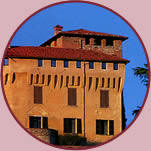 The
Serra regional wine center The
Serra regional wine center
200 types of wine, 20,000 choice bottles with a beautiful brick-vaulted
stone-walled cellar: these are the suggestive first impressions given to
visitors by
Enoteca Regionale della Serra (the Serra Regional Wine Centre), in the
Castello di Roppolo in
Piazza Castello 2, tel. 0161 98501
(open
Monday-Thursday 15:30-19:90, Friday through Sunday 9:30-12:30 and
15:30-19:30). In this ancient medieval manor in
Roppolo one can find all the wines of Piedmont, as well as those of Valle d'
Aosta, all of which having been admitted to the Enoteca only after passing a
scrupulously severe selection. In this fifteenth century cellar, with its
typically arched shelving reminiscent of ancient infernotti, there is
also an area dedicated to regional folklore, exhibiting a small collection
of traditional wine-making apparatus. The Castle also plays host to the
Festa dell'Uva (grape-harvest festival) in September, and many other
gastronomic and folklore events, conventions and seminars, all with the same
common denominator: wine.
|

